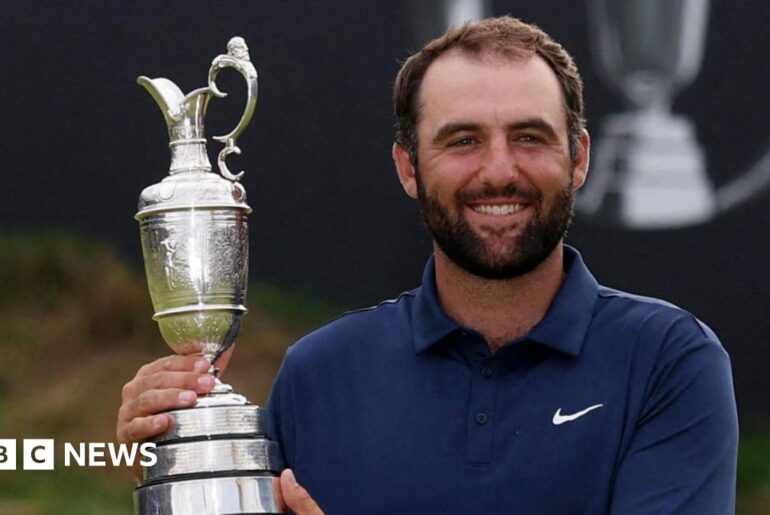Benton Harbor ― Colin Montgomerie has traveled all over the world to play golf, winning more than 50 tournaments in a career that has landed him in the World Golf Hall of Fame. But it’s here in southwest Michigan where the Scotland native and London resident admittedly feels right at home, having won the 2014 Senior PGA Championship at Habor Shores Resort, for the first major championship of his career, as well as his first official victory in the United States.
He has come back several times since to the Jack Nicklaus-designed course that Montgomerie calls one of his favorites, anywhere in the world. And now, he’s set to leave his own lasting legacy on the property.
The Wee Course, a nine-hole, pitch-and-putt course, is set to have a soft opening later this month, with Montgomerie set to play it Aug. 25, the day after he finishes competing in the Ally Challenge in Grand Blanc. And an official opening is planned for 2026, with the Montgomerie-designed course being the latest addition to a growing trend in golf in Michigan and throughout the country ― the renaissance of short courses.
The Wee Course is one of several short courses ― either a traditional par-3 course, or a fresh take, such as The Dozen at Arcadia Bluffs, which recently opened an innovative 12-hole course that is a mix of par 3s and par 4s ― that have been constructed in Michigan in the past five years, with more on the way.
“It’s to grow the game,” Montgomerie said earlier this summer. “COVID was a terrible pandemic, a terrible disease, but golf boomed, participation boomed during that, and just after that COVID time. … It’s important now to keep that boom going, and this is another asset to this.
“And I would encourage anybody to build these facilities, to give opportunities to youngsters, to get out into the fresh air, and to challenge themselves to put that ball into that hole.
“It’s another option, isn’t it? And options are good.”
The Wee Course is one of at least 10 traditional par-3 courses in Michigan, with nine-hole Doon Brae at Boyne also opening this summer. The seven-hole Little Cardinal opened at Saint John’s Resort in Plymouth Township in 2024. A reversible par-3 course is set to open in 2026 at Island Resort & Casino in the Upper Peninsula in 2026.
Short courses have proven to be good for business, and good for the game. At their roots, they’re another avenue of accessibility for people who can’t always afford traditional golf, either the price tag or the time commitment. They often can be everything to everyone, golfers and nongolfers alike.
Most of all, well, they’re darn fun. And, really, isn’t that the whole point?
“There really are no rules,” said Ken Griffin, director of golf sales and marketing at Boyne, which last month unveiled Doon Brae (built into the side of a ski slope), giving the resort an 11th course. That’s tied with North Carolina’s Pinehurst for the most in the country. “This is just about walking around and enjoying being out. Don’t be serious.
“It doesn’t have to be traditional golf as you know. Play for a score, or not. Just do what you want to do.
“And have fun playing golf.”
Par-fect alternative
Short courses aren’t new to the game of golf, but they’ve rode the wave of popularity and unpopularity for decades.
In the early 1990s, when Treetops Resort in Gaylord opened its nine-hole par-3 course, Threetops, guests weren’t immediately drawn to the idea of playing it. Par-3 courses often were looked down on by seasoned golfers.
Kevin Frisch was a golf pro at Treetops in the early 1990s, and he experienced the resistance.
“We had to kind of sell this concept,” said Frisch, now a public-relations consultant for several golf resorts in Michigan and throughout the country. “We would tell (the golfers) about it and they looked at me like I was an alien. A par-3 course? So I would tell them, ‘Go out and play it, and if you don’t like it, we’ll refund your money. (Owners) probably didn’t know that I was telling people that.
“And everybody just loved it. They thought it was the coolest thing.
“No one asked (for a refund). Everybody came in wanting to go play it again.”
Threetops ― with its signature hole, Devil’s Drop, which plays more than 200 yards from the tips, but has an elevation drop of more than 140 feet ― long has been the gold standard for par-3 courses. Built by Rick Smith, it eventually hosted a made-for-TV exhibition on ESPN featuring the likes of Phil Mickelson, Jack Nicklaus and Arnold Palmer.
That exposure helped make par-3 courses cool, and priorities for golf resorts, which saw them as money-makers ― given they were cheaper to build (they can be less than $1 million, as opposed to many millions for a full-scale, traditional course), and they didn’t require as much land.
Ray Hearn, an acclaimed golf-course architect based in West Michigan, has built three par-3 courses in Michigan, including, recently, Doon Brae (inspired by his trips to Scotland) and the Little Cardinal. In the early 2000s, he built the Strategic Fox, one of the few 18-hole par-3 courses anywhere in the country. The Strategic Fox is part of the Fox Hills property in Salem Township. He didn’t build any between Strategic Fox and the Little Cardinal, which was a supplement to Hearn’s bigger project at Saint John’s, building the 18-hole championship course that this month hosts LIV Golf.
“They just weren’t popular,” Hearn said of the decades-long lull in par-3 courses.
That’s not the case today. Hearn is currently working on seven short-course projects across six states, including Michigan, and he even had to turn down two others, in Texas and California.
He cited the golf boom, as well as the time it takes to play a short course ― about an hour, as opposed to four or five to play a traditional course ― as the chief reason behind the renewed popularity.
“Golf is addicting,” Hearn said. “I always say, it’s like a drug, and they want a quick fix with these short courses.”
No carts ― and, even better, no drivers ― required.
Short courses (called “executive courses,” in some circles) provide a solid function for the more-talented golfers, as an avenue to work on short irons, wedges and putting, without just using the practice facilities. And they’ve gained such a positive reputation in recent years, that in 2024, short courses as short as 750 yards (nine holes) or 1,500 yards (18 holes) have been eligible to be rated, and thus scores can be posted via the World Handicap System. At many resorts, short courses are another option for stay-and-play golfers for whom 18 holes in a day isn’t enough, but 36 is too much. They’re the perfect setting to settle some friendly wagers.
They’ve also proven to be the ideal entry point for new golfers, especially kids. It can be intimidating to break into golf on a so-called big-boy course. Short courses are better suited for teaching the game. Even Tiger Woods was famously taught the game, by his father, Earl, from the green out. He learned the short game first, everything else later. It worked out pretty well for him.
“Get children away from iPads and Gameboys,” Montgomerie, 62, said with a laugh. “Get out there and do something constructive. Is there a Tiger Woods out there? Is there a Scottie Scheffler, a Rory McIlroy? Is there a Nelly Korda out there? We don’t know without opportunity. This is going to give opportunity to children.”
Said Chris Whitten, executive director of the Golf Association of Michigan, and the former head coach at Michigan: “I think they’re perfect for the course that wants to reach a new segment of golfers. … (Short courses) will be on-ramps for new golfers for years to come.”
As golf green fees continue to rise to record levels, in Michigan and beyond, short courses offer a cheaper option. At many resorts, the short course can cost a quarter of the price a traditional course, if not even less than that. At many, kids play for free, or for a significantly reduced rate.
Golf’s sweet spot
Post-COVID, golf has experienced a boom like it hasn’t seen since Woods burst onto the scene in the 1990s, winning the 1997 Masters in record fashion. Michigan has led the way in terms of shattering records for years post-pandemic. Public tee sheets are booked, private roster rolls are full, and most courses are looking for ways to improve, through big-money renovations, or expand, through new courses.
Short courses have proven to be the sweet spot, because they don’t require the acreage of a traditional course (golf properties long have been running out of room, which is why the debate of scaling back the golf ball rages on), and they’re easier to maintain. The Wee Course, for instance, won’t have bunkers, to help with maintenance and pace of play. Some courses use mats for tee shots, to protect turf.
With the arrival of more short courses has, slowly, come the exodus of golf’s long-felt stuffiness. At Doon Brae, where they provide slimmed-down, old-school carrying bags (free to use, same as rental clubs), there are no strict tee boxes, but rather mere suggestions. Play from wherever the heck you want. On the ninth hole, the green’s so big, they use two pins ― use the one that’s closest to where your ball ends up.
At Forest Dunes in Roscommon, home of the 10-hole Bootlegger, golfers can play in 12somes, so long as they keep up the pace. They play barefoot. Music blares in the background.
“It becomes so much more of a social thing, a fun thing,” said Don Helinski, director of golf operations at Forest Dunes (which also is building a new, 18-hole, semi-private course, Skyfall, that’s slated to open in 2027). “It’s really thrown out a lot of the old adages about golf, that it’s too stuffy, too expensive, takes too much time to play, too many rules. This is just a lot of fun hanging out with your buds. You only need to take two or three clubs and your putter.
“It’s easy enough that first-timers and beginners can play, yet there’s enough of a challenge for even the low-handicappers to have a really good time.”
Forest Dunes, on most days, sees more than 100 golfers play the Bootlegger, the supplement to the resort’s nationally ranked Dunes and Loop (Red and Black; it’s a reversible 18) courses.
“Every time somebody opens a short course,” said Griffin, of Boyne, “it becomes their No. 1 course for play.”
Said Hearn, the architect: “Here’s the key ― you can’t make it plain vanilla ice cream. People won’t come.”
Short courses often are accompanied by large putting courses, like at Saint John’s and Boyne. At Boyne, Doon Brae and its adjoining putting course, 1.5-acre, 27-hole Back Yaird, are bordered by lights, for night play, located just outside the resort’s main pub and grille, making it a fun gathering place, particularly at day’s end.
Putting courses appear to be another new industry fad, like at Bucks Run in Mount Pleasant, which has a standalone, 18-hole putting and chipping course called Short Game Island.
The game of golf is always evolving and growing, but that doesn’t mean it’s always getting bigger, in the literal sense. As many courses in Michigan are finding out with the short-course boom, bigger isn’t always better.
“Anybody can play, even non-golfers. If you can’t chip a ball, you can putt your way around the golf course,” said Jeff Fettig, former chairman and CEO of Whirlpool Corporation whose Fettig Family Foundation is overseeing the Harbor Shores expansion, where the Wee Course will be outfitted with a course-record leaderboard and a Monty’s Place halfway house (a spin off Jack’s Place, on the big course). “We’re very excited that we’ll be open to even more people.
“It’s fun, and affordable.”
tpaul@detroitnews.com
@tonypaul1984







